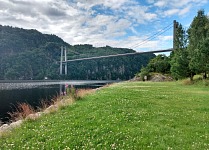 |
| Meeting our first true (Feda)fjord. |
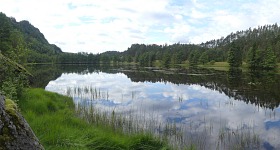 |
| A mirror lake named Ytre Lona on our way to Sirdal. |
Our last journal ended in a language corner; this one begins there. We had
agreed with the other Czech expedition that we would stop by their cottage
and should they not be there, we would meet at Kjerag. That name sounds in
Norwegian close to "Cherag." Here we arrive at a problem with the
Norwegian language — whose written form can be quite well understood
if one is familiar with German and English (which, after all, contain Old
Norse words since Viking times) — e.g., Norwegian
forbudt matches
German
verboten or English
forbidden. The problem emerges when
Norwegians begin to speak — their spoken language includes a whole lot of
soft consonants, which on first listen sound like Czech — yet then a Czech
(person) wonders, why it is she understands none of it. Well, would you guess
that a Norwegian saying "ushlo", refers to their capital city? Locals
casually greet each other saying "hei", pronounced just like
(American) English "hi" — so whenever we greeted Norwegians
on hikes, in hotels and restaurants, they automatically continued talking to us
in their language, and only after a while our uncomprehending expressions
stopped them.
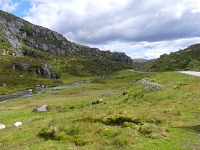 |
| Lansdcape turns into tundra as altitude increases. |
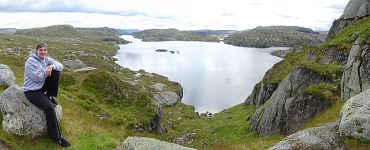 |
| Borsteinvaten: one of many lakes on he high plateau. |
About Kjerag. The Czech expedition lodged at Sinnes, which is a recreational/ski
resort in Sirdal region, connected by a high plateau with Lysefjord. We had
booked a hotel in Sandnes (the closest larger city), but could check in only
later afternoon — thus it made sense to spend the day outside somewhere,
get together with friends in the evening, and fall back to a comfortable hotel
for the night. Do you know the old say that if you want to entertain gods, you
should tell them about your plans? So; at the moment we were still on our way
toward Sinnes. There, another specifically Norwegian "problem" appears
— it is beautiful EVERYWHERE. Thus we would stop at an arbitrary point
along a county road with a brook and small lakes, which sported a completely
calm surface. For us, from windy Wyoming, this is truly exotic (don't even ask
how many pictures of water reflections we brought from Norway). Besides a pretty
lake, we found blueberries in the woods. Thousands of blueberries, which we
snacked on. We reached the cabin, naturally, at a moment when our friends were
long gone (as we had anticipated). We did not let that faze us and proceeded to
Kjerag. Across a breathtaking high plateau, along a narrow road, where we kept
having to carefully pass with the opposite traffic — and with sheep.
Those were oblivious to cars, but frequently made their beds on shoulders or
under guardrails, until one worried about running over tails, hoofs or ears.
 |
| Road to the upper end of Lysefjord. |
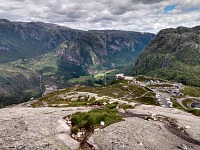 |
| Parking with a restaurant from the first part of Kjerag hike trail. |
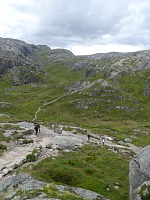 |
| The actual Kjerag, a pinched boulder, is 3 miles farther up this crowded trail. |
While still on the road, we met a car with a Czech license plate driving in the
opposite direction; we thought that it could be Jára — and that our
athletic friends were returning from their trip, for we were greatly delayed
thanks to our stopping and taking pictures. When we finally reached a parking
lot under Kjerag, we discovered that perhaps half of the visitors were Czechs
and Slovaks — and the car in opposite direction might not have carried our
friends at all. Sid claimed that it's only "small distance" to Kjerag,
but the trail arrow said something about six kilometers — which still
seemed not so horrible to us — and so we set out on our way rather
merrily. Our humor evaporated after about an hour, having dragged ourselves for
about an hour uphill across rock slabs, holding onto chains, when a jolly Slovak
dude told us that there would be three more such hills and we'd be there.
Indeed when we finally scrambled up on top of our hill, there was a valley
opening before us, with another hill on the opposite side — with a steady
stream of people rolling up and down this avenue. My knees were hurting and
clouds bunched over the cliffs on the other side of Lysefjord, followed by
a gray curtain of rain. We took a break for lunch to think it over near a small
rock with a view, and I eventually outvoted Hippo in that it made no sense
to claw up the nearest summit in rain.
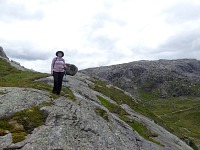 |
| It rains lightly and we're starting to turn back. |
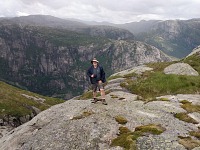 |
| The fjord is (somewhere) down there in the canyon. |
The way off the hill was much worse than going up, for it really started raining
and the rock slabs, which had been just a huffing and puffing challenge on the
way up, now turned into a treacherous slide. Hippo soon found out with his own
back — when his feet slipped from under him and not even clutching a chain
would help him. Given the fact that his camera smacked into his face and he was
bleeding from a burst lip, he looked like a real accident victim. Rubberneckers
were rubbernecking and offering advice, soon to join him in toppling or at least
windmilling. We resolved to remedy our trauma with a beer at the parking
restaurant — and watched from there as the REAL rain arrived —
and congratulated ourselves to our cowardice, which saved us from the worst
deluge. Thus invigorated we proceeded to our car — still watching, as
less fortunate tourists, who did not make it under a roof in time, squelched
downhill, soaking wet and freezing.
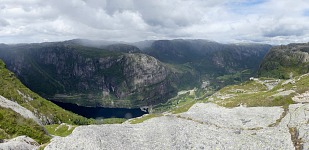 |
| Lysefjorden and a village named Lysebotn some 2,300 ft lower. |
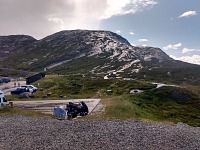 |
| View from the restaurant to the hill transformed into a slide. |
An encounter with Norwegian digitization awaited us at the parking lot exit.
When we entered the lot around noon, the gate was raised up. When leaving, the
gate was down with some machine nearby and a sign that we should wait for it
takes the gate a while to lift. The arm did not move for a second, two, ten,
half a minute — a car behind us started honking. I went to ask why the
gate would not lift, and they said we must pay. Further investigation revealed
that a machine reads the license plate upon entry; before exiting one must
locate a pay machine and enter the plate in, pay, and then get in the car and
drive out — hoping that robots had understood everything correctly and
one is allowed to depart, since throughout the entire process one never receives
any document about parking or payment. The absence of disclosure of prices also
startled us — our feeble attempt to scale the first hill of the Kjerag
trail cost us US$30. Apparently high mountain surcharge. We had no idea about
the parking payment system even back in Mandal, therefore after a while our
rental car bill was automatically charged $2.50 for parking in a grocery store
garage. Big Brother is simply watching and tracking you everywhere.
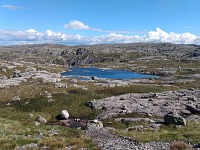 |
| Lyseveien: a lake in tundra. |
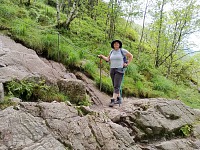 |
| Carol prepares to ascend along a chain to Månafossen waterfalls. |
We sped at a dizzying speed of about twenty miles an hour (a lot slower when
passing sheep, in turns and dodging incoming traffic) and looked forward to
our meeting with friends. Alas, the cottage remained locked up, nobody around
(not even cars). We reckoned that they possibly went shopping or something like
that. Since our American phones could only operate on WiFi, after a while we
decided to head to our hotel and find some dinner for ourselves. Later we
learned that at the time we loitered at the cottage, they were still scaling
rocks half way back from Kjerag — having been caught in that deluge, and
from whence they were therefore bound to descend quite carefully.
The city of Sandnes was a nasty surprise at first glance. I mean
"nasty" in the sense that we found ourselves in a strangely
post-industrial, soulless downtown, which seemed to consist mostly of one
way streets or those closed to regular traffic, including the one leading to
our hotel, which was thus impossible to reach legally with a car. Given that
we had chosen the hotel for HAVING a parking place, this took us aback.
Eventually we parked somewhere beyond train tracks and walked to the hotel to
ask, where this parking of theirs was. The receptionist looked rather surprised
— there was no hotel parking. But we might like to park at the nearby
shopping mall for mere 230 Norwegian crows (i.e., US$23) every 24 hours.
We felt rather sour at that; I think that Expedia (through which we booked the
hotel) has plenty to explain. On a similar vein, the receptionist denied
having guest laundry services (another advertised amenity, which made us choose
this particular hotel, as we could not carry supply of clean clothes for almost
three weeks along to Norway). She said that they contract external cleaning
services, priced per item. We quickly searched for another accommodation in town
that would satisfy those conditions, finding none. The receptionist said that
she could upgrade us to a better room, now that we'd been had by Expedia.
A weak consolation, but we understood that a hotel front desk worker can't
be responsible for Expedia screw-ups.
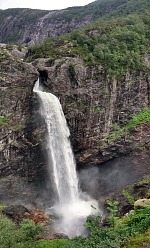 |
| Månafossen. |
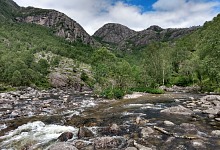 |
| A pretty creek, Frafjordelva, flows out of the waterfalls. |
We settled in the room — which had a TUB in the bathroom — where
I could therefore try to was by hand the most critical pieces — and we
set out in search for dinner. A Thai restaurant was supposed to be open till
eight thirty, two blocks from the hotel. It was shortly before eight, door to
the restaurant stood ajar with an APEN sign and opening time indicated till
20:30, but the server hollered at us that she had closed and is not cooking
anymore. Well... we stood in the pedestrian zone that looked rather deserted.
Eventually we realized we should not play heroes, and went to the only open
establishment in the vicinity — a steakhouse. There, we had a horribly
expensive, but also excellent dinner (Hippo claims that it was the best steak
he ever had), and local beer Tou. After a day full of disappointments I had
a feeling that gods above laugh a gut-grabbing laugh (we hadn't scaled Kjerag,
haven't met our friends, our hotel missed the two reasons that were momentarily
quite important, and even the stupid restaurant had closed in our face) —
at least we could drink to that.
Everything looked much rosier in the morning, even our plans improved —
while our friends organized a fjord ferry tour, we headed to Frafjord and
Månafossen waterfalls.
This arrangement counted on us being relatively soon finished with our outing,
and that we would get together at five o'clock at the cottage for a barbecue.
At Månafossen we encountered another Norwegian digital trap — parking was
paid through the VIPPS system — specifically Norwegian, phone application
software for all public payments. Lacking a Norwegian phone, verily their
payment software and account as well, but also lacking exact change in Norwegian
currency, which can be inserted into a slot as a last resort, we ended up not
paying for parking. The idea how we drive another hour and half to civilization
in search of an ATM, then beg at some kiosk for the exact change, did not appeal
us as realistic (by the way — we subsequently extracted some cash in NOK,
only to never need it again). Hike up to the waterfalls consisted of rock slabs
and chains, but also of irregular stone steps. My arthritic knees did not like
it a single bit, but it was not far, fortunately. And the waterfalls were
awesome. On our way back we ran into an Italian group, whose guide got to
chatting with us, revealing a secret that we must visit the most famous tourist
attractions toward evenings — as majority of visitors must be back on
boards their giant cruise ships between four and six o'clock, and thus all
groups start early.
And given that Norwegian sun sets at eleven, lots of places can be
enjoyed later in the afternoon without cruise crowds. We stored this information
as very pertinent, but for the rest of our trip we kept opting for another
system — avoiding famous tourist attractions altogether.
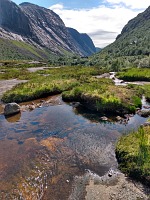 |
| Øvstabødalen: the creek flows directly across rock bed. |
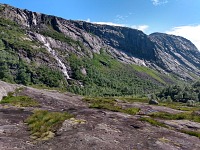 |
| Inconspicuous waterfalls with sheep near Øvstabøstølen. |
Driving up to Sinnes, we randomly stopped near the Hunnå Creek, which we
found lovely — where Hippo fell again, having jumped a brook onto
a rock slippery with algae. I began to worry how long he would last me, falling
on the ground somewhere every day, but I think this was his last fall on this
trip. Hence I am happy to be unable to report about Norwegian health care.
We liked it at the creek very much, but an hour of our cottage meeting
approached and on top of that a bunch of sheep headed our way from the
waterfall. They bleated and seemed to want something, and we chose to move on.
Barbecuing and chatting with friends lasted long — we viewed pictures from
that historic expedition, which was a lot of fun. I gradually grew tired, but
did not understand why. Only a look at the clock cleared it up — it was
ten in the evening and the sun only started leaning to the horizon. We found
ourselves in the trap of Norwegian white nights — confused by our jet lag
without the safety rope of regular day and night cycle — we were floating
through time sequences and days like Flying Dutchmen. So it came to pass
that we returned to our hotel room considerably after midnight. We still had to
sort out tickets for a ferry to Lysefjord, which had to be bought online and in
advance, in no case on the spot by the boat. One can sail Lysefjord in three
simple ways. The first and most advertised method involves paying for a cruise
tour to Hengjanefossen waterfalls from Stavanger. The cruise ship takes you from
the city into the fjorden's mouth, where you may look up in awe to Preikestolen
— the famous Pulpit Rock — and marvel at nearby waterfalls; quickly
then, they will hurry you back to the city. The other method involves booking
a ferry trip from Lauvvik, where you drive you car on board, subsequently
driving it off the boat in Lysebotn at the very end of the fjord —
then you drive ut the vertigo-inducing hairpin switchbacks to the Kjerag
parking lot, and from there you take the overland route (or alternatively, you
book and drive the same route in the opposite direction). We were intrigued by
such prospect, especially the switchbacks, but it turned out that this late,
car ferry spots were sold out. Thus we chose the third method — we would
take a boat reserved for pedestrians only, going the full length of Lysefjorden
there and back, while our car waits at a parking lot in Lauvvik.





















